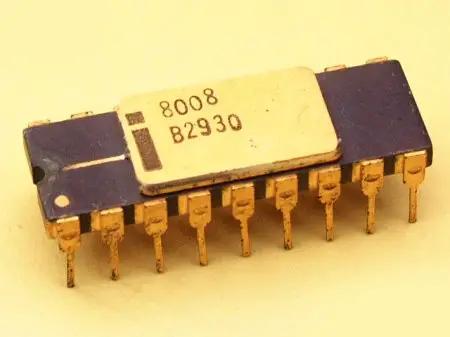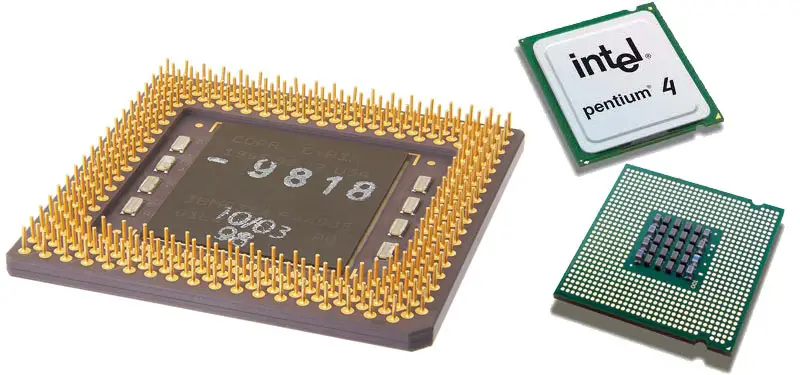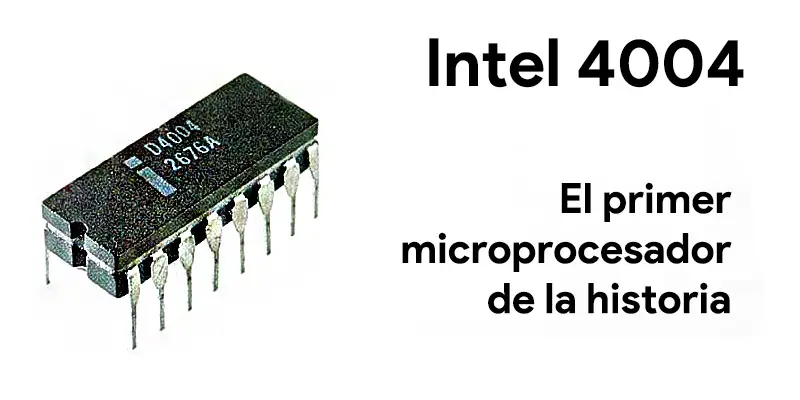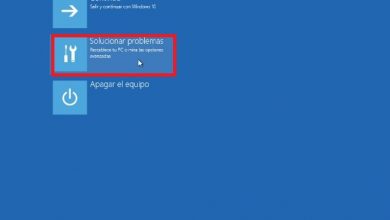Microprocessor: what is it, what is it for and what are its characteristics?

Today, the use of computers is so widespread that many times we forget, or put aside, fully understand each of the components that make possible the operation of these marvels of technology.
In this article, we are going to introduce you to everything that has to do with the microprocessor , a component without which it would be impossible to do everything you can do with your computer. You will understand all of this as you delve into reading our Today's Delivery, as we are going to go through aspects such as the functions of the microprocessor, its uses in computer science and characteristics the most important that accompany it.
In the same way, you will discover there data on its history and its evolution , in addition to knowing chronologically the marketing of some of the microprocessors that have left their mark in the computer world.
What is a microprocessor and what is it used for in computing?

The most common way to conceptualize the microprocessor is to call it the brain of the computer. This gives us a clear idea of its vital importance in the functioning of the computer, because without it it would be impossible to perform most of the operations that occur in the computer.
Commonly called a processor, it is integrated into the motherboard of the computer, passing all simple arithmetic and / or logic operations, up to binary logic and memory access. In this way he allows the execution of programs , which range from a particular operating system to user applications and software.
Likewise, you should know that a microprocessor can be consisting hundreds of thousands of integrated circuits within a silicon chip or tablet. This chip is attached to the CPU motherboard through a socket in conjunction with an anti-heat system, which is made up of an internal fan and specially designed materials to dissipate heat.
At this point, we have to stop at the method of manufacturing a processor, which comes from a not simple process. It all starts with extracting silicon from sand containing quartz in sufficient quantities to meet the unequivocal optimization requirements of the final product.
About the performances microprocessors, it should be emphasized that although there is no established metric for this purpose, it is possible to affirm that everything will depend on the demands to which they may be subjected according to the equipment where they are installed.
What are the main functions of a microprocessor in a computer?
Before going directly to the main functions that the microprocessor is capable of performing in computers, it is important to show that today it is by far the product of the technological industry the most used by everyone in the world. the world. Indeed, it is necessary for operation of a wide range of everyday devices .
Its operation stops for a synchronization perfect in stages , so that everything goes as planned in its design. It is thanks to a clock that coordinates everything that is developed in the functional blocks.
To illustrate the process a little more, we will tell you that the microprocessor connects to a high performance PLL circuit which helps it to perform the functions. stored instructions as binary digits in its main memory.
The process begins with the receipt of instruction , its decoding and the search for compatible programs to execute the command; done this, analyze the data provided; and, finally, it shows us the final results of the whole process before moving on to the next order, in a measured time in fractions of a second .
What are the most important defining characteristics of a microprocessor?

To talk about the characteristics common to all microprocessors, it is must be done by describing part of their architecture . Thus, to fully comply with its operation, each part must meet specific characteristics.
We present them here in more detail:
- Encapsulated : it is the jacket or the cover which serves as a protector for the silicon tablet in which the small device was manufactured. This ensures that it is free from dirt particles and oxygen oxidation.
- cache : this part of the microprocessor is in charge of saving the data which can be used immediately without having to go to the RAM memory , thus reducing response times between one instruction and the next. This gives it super-fast memory properties.
- Mathematical coprocessor : We could define it as the brain of the processor, since in this section the mathematical calculations are done. It acts as a floating point unit.
- registers : It is a kind of small memory made up of two groups totaling 32 registers, each group being dedicated to the control of specific functions within the microprocessor. One of the groups was designed to prevent the processor from getting out of control on its own; while another serves to help the CPU in certain tasks.
- Memo : it is the part towards which the device goes when it receives an instruction, because it is there that the programs and their data are stored.
- Ports : they are responsible for maintaining a constant and coordinated link between all the other components of the computer. In other words, they are the ones who put into action the various circuits and other parts of the system when they are needed.
History and evolution of the microprocessor When and who invented them?
If it should be noted that the microprocessor derives from technologies that began around the 50s, such as computing and the semiconductor field, it is also worth noting that its birth goes back to 1971 . It was that year that the fusion of previous technologies has resulted in the semi as we know them today.
Marcian E. Hoff , who at the time worked for the company Intel, is considered to be the father of this great invention, which undoubtedly came to revolutionize the world of computing and become an indispensable tool for many tasks of modern life.
It should also be noted that the engineer Hoff had the collaboration of his colleagues Federico Faggin, Stanley Mazor and Masatoshi Shima , which history recognizes as co-inventors. However, it must be clear that the authorship of the invention has always been attributed to Hoff, since it was he who presented the proposal in 1969.
The invention came to be the Intel 4004, 4-bit, the first commercial microprocessor. It was a programmable processor, assembled with 2 transistors in a single capsule, which very quickly ceased to meet the demands that advances in computing were beginning to demand.
Of course, the above resulted in the search for improvements in design and capabilities, with which the microprocessor began its evolution until amazing developments that we know today. But we'll develop this topic in more detail in the next section.
Chronology of the most important microprocessors in the history of computing

In this part, we will leave you a sample of the processors which marked an important stage in the unstoppable evolution of microprocessors, who have currently been able to reduce their scale of integration, in the micro beginnings, at the nanoscale :
Intel 4004
As we have already said, it is the first microprocessor marketed in the world. It was able to address 4096 locations, with its 4-bit memory. Its architecture allowed it to perform up to 60 operations per second , thanks to the fact that it could operate at a clock frequency of around 700 KHz.
"UPDATE ✅ A microprocessor is a piece of hardware that runs the processes to keep the computer running ⭐ ENTER HERE ⭐ and learn more about it"
One of its limitations, which ultimately led decisively to the search for improvements to the system, was that it could only serve a set of 45 different instructions . It didn't allow it to serve too many apps, so at first it was only used in apps with limited resources.
Intel 8008
Introduced in mid-1972, the 8008 itself was intended for efficient use in computer terminals. 3300 transistors have been integrated into its small capsule , which gives us an idea of progress made at that time.
It should be noted that it ushered in the era of 8-bit microprocessors, which allowed memory to be extended up to 16 Kbytes. This way he was able to process up 48 additional instructions , at clock frequencies up to 800 KHz.
Intel 8080
It first saw the light of day in 1973 and was intended for countless uses. Although it is still an 8-bit microprocessor, the developers have managed to make it address a larger amount of memory. In this way, he was already able to carry out the instructions in a time 10 times less than that of its predecessor.
In addition, the 8080 was a big step in the achievement of the interconnection with most standard TTL type components, thanks to the compatibility of this microprocessor with said calculation logic.
SC/MP
Introduced in 1974 by the National Semiconductor Company , it quickly became popular due to its low cost. It was equipped with an 8-bit data bus in combination with a 16-bit address bus.
Another reason for its wide acceptance has to do with the fact that the released buses could be shared by multiple processors simultaneously, being the first to have this functionality.
Motorola 6800
In order not to be left behind in the career of computer development, the Motorola company presented this proposal in 1975, which was integrated into a large number of early microphones - computers that were already starting to be seen in those years in the mid-70s.
It marked an important step in the evolution of microprocessors, because it was the first to be equipped with a index register . Several of the most recognized microprocessors of this brand have been derived from it.
Intel 8086
The first 16-bit microprocessor, the 8086 entered the market in 1978 and undoubtedly represented a gigantic advance in the world of computing. Its 29 transistors allow it to execute instructions in just 400 nanoseconds . It was the first capable of running 1MB of memory.
At the time of its launch, applications capable of running in 16 bits were practically non-existent, so the manufacturer was forced to present its model. 8088 , with the idea of retaining its market share.
Intel 80386
We are already talking about a microprocessor here 32 bits , marketed in the mid-80s. Thanks to the fact that it had 275 transistors, it could reach speeds of 000 MHz and its memory space was Go 4 .
Among its new features is the simplification of the implementation of operating systems requiring virtual memory, thanks to the page translation unit integrated into this chip.
DEC Alpha (AXP)
Undoubtedly a revolution in the world of microprocessors, it was equipped with a set of RISC instructions from a capacity of 64 bits , specifically dedicated to floating point calculation. From then on, computers were able to represent real numbers more efficiently.
It should also be noted that after its appearance, in 1992. , microprocessors began to be designed to operate on registers , so the RAM was only needed for loading and storing instructions.
Intel Pentium
It is a microprocessor 64 bits , which made its introduction in 1993. Although the DEC Alpha came out before it in 1992, the Pentium became more popular because it was much cheaper than its rival. In the manufacture of each unit, 3 transistors have been used for a memory capacity of 4 GB and a working frequency of 66 MHz.
The Pentium a without a doubt marked an era in the technological field, being a name widely used in the computer spectrum. There are many developments based on its 64-bit data bus.
Although the ones we have presented to you have marked a before and after in the unstoppable evolution of microprocessors there have been and will continue to look more amazing every day, so at present we have a number and variety to use in different fields.
If you have any questions, please leave them in the comments, we will get back to you as soon as possible, and it will be a great help for more community members as well. Thank you!




